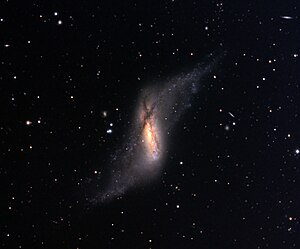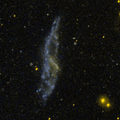NGC 660
| Galaxie NGC 660 | |
|---|---|
 | |
| Amateuraufnahme | |
| AladinLite | |
| Sternbild | Fische |
| Position Äquinoktium: J2000.0, Epoche: J2000.0 | |
| Rektaszension | 01h 43m 02,40s[1] |
| Deklination | +13° 38′ 42,2″[1] |
| Erscheinungsbild | |
| Morphologischer Typ | SB(s)a pec, HII, LINER, Sy 2[1] |
| Helligkeit (visuell) | 10,7 mag[2] |
| Helligkeit (B-Band) | 11,7 mag[2] |
| Winkelausdehnung | 8,3′ × 3,2′[2] |
| Positionswinkel | 170°[2] |
| Flächenhelligkeit | 14,1 mag/arcmin²[2] |
| Physikalische Daten | |
| Zugehörigkeit | M74-Gruppe LGG 29[1][3] |
| Rotverschiebung | 0,002829 ± 0.000002[1] |
| Radialgeschwindigkeit | (848 ± 1) km/s[1] |
| Hubbledistanz H0 = 73 km/(s • Mpc) | (42 ± 3) · 106 Lj (12,8 ± 0,9) Mpc [1] |
| Durchmesser | 100.000 Lj[4] |
| Geschichte | |
| Entdeckung | Wilhelm Herschel |
| Entdeckungsdatum | 16. Oktober 1784 |
| Katalogbezeichnungen | |
| NGC 660 • UGC 1201 • PGC 6318 • CGCG 437-012 • MCG +02-05-013 • IRAS 01403+1323 • GC 390 • H II 253 • PRC C-13 | |
NGC 660 ist eine aktive Balken-Spiralgalaxie mit hoher Sternentstehungsrate im Sternbild Fische auf der Ekliptik, die etwa 42 Millionen Lichtjahre von der Milchstraße entfernt ist. NGC 660 ist eine der wenigen Polarring-Galaxien.
Das Objekt wurde am 16. Oktober 1784 vom deutsch-britischen Astronomen Wilhelm Herschel entdeckt.[5]
2012 wurde bei Beobachtungen mit Radioteleskopen eine plötzlich erhöhte Aktivität gemessen. Neuere hochauflösende Beobachtungen zeigen eine neue, extrem helle Radioquelle innerhalb von NGC 660. Als Deutung kommt ein wachsendes supermassives Schwarzes Loch (SMBH) vermutlich mit einer Masse von 20 Millionen Sonnen in Betracht. Erstmals kann nun beobachtet werden, wie ein extrem massereiches Schwarzes Loch seine Aktivität entfaltet.[6]
- (c) ESA/Hubble, CC BY 4.0
Detaillierte Aufnahme des Zentrums, Hubble-Weltraumteleskop
Aufnahme der Ultraviolet-Emission mittels GALEX
Aufnahme mithilfe des Gemini-Teleskops
Literatur
- König, Michael & Binnewies, Stefan (2019): Bildatlas der Galaxien: Die Astrophysik hinter den Astrofotografien, Stuttgart: Kosmos, S. 321
Weblinks
- Rare Polar-Ring Galaxy Captured in New Image, NGC 660 aufgenommen mit dem 8-m-Gemini-Teleskop
- Compact Radio Sources in NGC 660
- Polarring-Galaxie NGC 660 – Astronomy Picture of the Day vom 22. Januar 2011.
- A bizarre cosmic rarity: NGC 660 (engl.)
- Spektrum.de: Amateuraufnahmen [1]
- CDS Portal
- SIMBAD Astronomical Database
- NGC 660 is a rather peculiar galaxy
Einzelnachweise
Auf dieser Seite verwendete Medien
NGC 660 by GALEX
Autor/Urheber:
Credit:
NGC 660
"This Gemini North telescope image captures the “bloody” aftermath of one galaxy piercing the heart of another. All the action appears in a single frame, with the stunning polar-ring galaxy NGC 660 as the focus of attention. NGC 660 spans some 40,000 light years across and lies about 40 million light years distant in the direction of the constellation of Pisces. It has an unusually high gas content and resolves into hundreds of objects, a considerable fraction of which are blue and red supergiant stars. The ring’s youngest detected stars formed only about seven million years ago, indicating a long and ongoing process of formation. As NGC 660’s ring is not truly polar, but inclined ~45˚ from the plane of the disk, it most likely formed by a previous interaction with a gas-rich galaxy about a billion years ago. That event would have stripped the interloper of its gas, directed it into NGC 660’s core, and triggered a furious burst of star formation. When the resulting short-lived, massive stars exploded shortly thereafter as supernovae, they would have generated shock waves that triggered more star formation, and so on, even to this day. " This image of the ring galaxy NGC 660, obtained with the Gemini Multi-Object Spectrograph on the Fredrick C. Gillett Gemini North telescope was obtained in August of 2012. The image is made from three images taken through g, r, i, and hydrogen alpha filters and assigned the colors of blue, green, orange and red respectively in this color composite image. The field of view is 9.3x5.6 arcminutes and it is oriented 8 degrees clockwise from north at right and east up. The total exposure (integration) time is 1,620 seconds for all filters. Color composite produced by Travis Rector, University of Alaska Anchorage.
Credit:
International Gemini Observatory/AURA(c) ESA/Hubble, CC BY 4.0
This new Hubble image shows a peculiar galaxy known as NGC 660, located around 45 million light-years away from us.
NGC 660 is classified as a "polar ring galaxy", meaning that it has a belt of gas and stars around its centre that it ripped from a near neighbour during a clash about one billion years ago. The first polar ring galaxy was observed in 1978 and only around a dozen more have been discovered since then, making them something of a cosmic rarity.
Unfortunately, NGC 660’s polar ring cannot be seen in this image, but has plenty of other features that make it of interest to astronomers – its central bulge is strangely off-kilter and, perhaps more intriguingly, it is thought to harbour exceptionally large amounts of dark matter. In addition, in late 2012 astronomers observed a massive outburst emanating from NGC 660 that was around ten times as bright as a supernova explosion. This burst was thought to be caused by a massive jet shooting out of the supermassive black hole at the centre of the galaxy.





